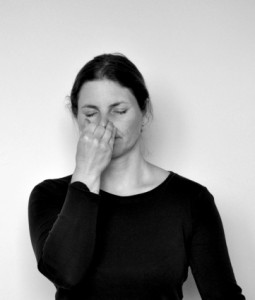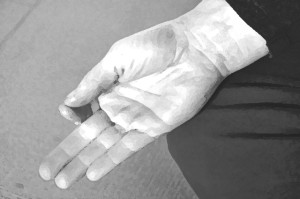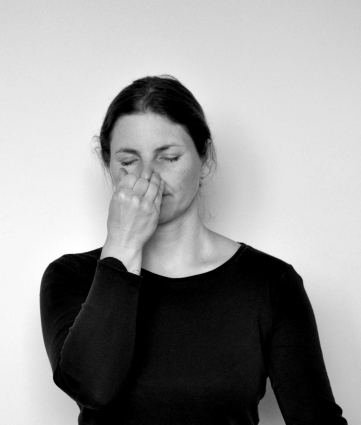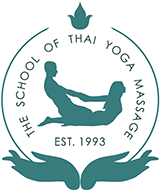In a few previous posts, we talked about Abdominal Breathing and Complete Yogic Breath. Today we will focus on another pranayama practice: Anuloma Viloma – Alternate Nostril Breathing.
~
Pranayama is the link between the mental and physical disciplines. While the action is physical, the effect is to make the mind calm, lucid and steady. – Swami Vishnudevananda
~
Alternate Nostril Breathing corrects many negative breathing habits, as well as helping you to balance how you use the two sides of your brain – the logical left side and the creative right side. Research has shown that there is a connection between this and the airflow in our nostrils: when the right nostril is more open, the left brain hemisphere is more active and vice versa.
There are 4 steps in the practice:
- Exercise #1: Single nostril
- Exercise #2: Alternate breathing
- Exercise #3: Full alternate breathing 1:2:2
- Exercise #4: Full alternate breathing 1:4:2
How to Practise – Exercise #1
- Sit in any comfortable position keeping your spine, neck and head in a straight line. Close the right nostril with your thumb.
- Inhale slowly through the left nostril counting mentally 3 seconds and exhale through the same nostril while counting 6 seconds. Exhalation time is always twice the inhalation time. The proportion is 1:2.
- If you find the proportion 1:2 too straining count to 4 instead of 6, then increase to 5 and once comfortable increase to 6.
- Repeat the breathing into the left nostril for about 15-20 times and then switch to the right nostril.
- Close your left nostril with your right ring finger and little finger, and inhale through the right nostril. Repeat steps 2-4 using your right nostril.
- The length of inhalation and exhalation can be slowly increased to counting to 8 for inhalation and 16 for exhalation. Higher counting than 4 seconds for inhalation and 8 seconds for exhalation is suggested to practise under teacher supervision.
How to Practise – Exercise #2
- Close the right nostril with your thumb and inhale through the left nostril. Now close the left nostril immediately with your right ring finger and little finger. Remove your thumb from the right nostril and exhale through that nostril. This is a half round.
- Now without pausing, inhale through the right nostril. Close the right nostril with your right thumb and inhale through the left, as previously. This makes one full round.
- The proportion of inhalation is 1:2 as in Exercise #1. Do about 15-20 rounds.
- The length of inhalation and exhalation can be slowly increased to counting to 8 for inhalation and 16 for exhalation. Higher counting than 4 seconds for inhalation and 8 seconds for exhalation is suggested to practise under teacher supervision.
~
Pranayama consists of specific breathing techniques that encourage the absorption of prana into the body’s subtle energy channels (nadis) and energy centers (chakra), enhancing overall vitality and well-being.
~
How to Practise – Exercise #3
- In this practice, we introduce retention – holding of the breath. The ratio between inhalation and retention is 1:2 to start with and then continue to 1:4.
- Start with 3 seconds inhalation, 6 seconds retention and 6 seconds exhalation – 3:6:6 and then slowly grow into 8:16:16.
- Use the same body posture and hands position as for Exercise #1 and #2.
- Inhale the air through the left nostril while counting mentally to 3. Retain the air while counting to 6. Exhale through the right nostril while counting to 6. Now without stopping inhale through the right nostril, retain the breath, and exhale through the left nostril – all in the same 3:6:6: proportion. This is one full round.
- Practise 15-20 rounds.
- The length of inhalation, retention and exhalation can be slowly increased to 8:16:16. Higher counting than 4:8:8 is suggested to practise under teacher supervision.
How to Practise – Exercise #4
- Increase of retention period
- Once you are comfortable with Exercise #3, change the ration to 1:4:2.
- Start with 3 seconds inhalation, 12 seconds retention and 6 seconds exhalation.
- The length of inhalation, retention and exhalation can be slowly increased to 8:32:16. Higher counting than 4:16:8 is suggested to practise under teacher supervision.
~
Once you start practising regularly you would be able to see tremendous changes taking place in your body and mind. The breathing will become perfect, especially the movement of the diaphragm. The body becomes very light and the eyes shine. When these signs become apparent, it shows that the nadis are being purified.
~
The Mudras (hands position)
Vishnu mudra:
There are 2 options for Vishnu mudra (different across traditions)
a) Without holding a Third Eye chakra:
- Use your right hand and make a fist.
- Release your thumb, ring finger and little finger.
- Lift your right arm, bend it at the elbow and bring your hand close to your nose.
- Block your right nostril with a thumb and left nostril with a ring finger and little finger.
b) Withholding a Third Eye chakra:
- Use your right hand.
- Bring the index finger and middle finger together.
- Lift your right arm, bend it at the elbow and bring your hand close to your nose.
- Rest your index and middle finger on the Third Eye chakra (gently up and between your eyebrows).
- Block your right nostril with a thumb and left nostril with a ring finger and little finger.
Chin mudra:
- Place your left hand on your left knee, turning the palm upwards.
- Gently join the tip of the index finger (representing the individual consciousness) against the tip of the thumb (representing the cosmic consciousness).
- The other three fingers remain joined and extended in a relaxed position.
Watch Out For
- Make sure that you can comfortably practice Abdominal Breathing and Complete Yogic Breath then you can start with Anuloma Viloma – Alternating nostril pranayama practice.
- Do not try the higher proportion until you are able to do the lower proportion very easily. This is the main rule in every breathing practice. Always keep within your capacity and never overdo.
- Do not rush. Make sure that your body and mind are relaxed during the practice. Always go in your own pace within creating any tension within your body and/or mind.
- The wrong fingers are used.
- Back is not straight; head drops forward. Shoulders are tense.
- The chest drops with exhalation or shoulders raising up with inhalation.
- The breath is not smooth or exhalation is too quick or insufficient.
- Breathing through the mouth.
- Inhalation and exhalation occur too rapidly. Make sure that you try to follow the rhythm set by the teacher.
~
Through pranayama, the body becomes strong and healthy. Too much fat is reduced. There is a lustre in the face. Eyes sparkle like diamonds. The mind becomes one-pointed.
~
Benefits:
Physical benefits
- The lungs and the entire respiratory system are cleansed and strengthened.
- As exhalation is longer than inhalation, more stale air and waste products are expelled from the lungs.
- During retention, the rate of gaseous exchange in the lungs is greatly increased. This means that more oxygen from the lungs goes into the bloodstream and more CO2 (and other waste products) from the blood are passed into the lungs for elimination during exhalation.
- The breath naturally alternates between the two nostrils, changing approximately every 2 hours. The breath in the right nostril is hot, symbolically referred to as the ‘sun’ or pingala. It is catabolic and acceleratory to the organs of the body. The flow from the left, which is cool and referred to as the ‘moon’ or ida, is anabolic and inhibitory to the body. This alternate breathing practice helps to bring equilibrium between the two.
- It helps to balance the hemispheres of the brain.
Mental benefits
- When the breath wanders – is irregular, the mind is also unsteady.
- When the breath is still, so is the mind and the yogi lives long.
~
Steady practice of pranayama arouses the inner spiritual force and brings in ecstatic joy, spiritual light and peace of mind.
~
Source: Sivananda yoga teacher’s training manual, Personal experience and practice
Photo: VIVA Photography








Recent Comments